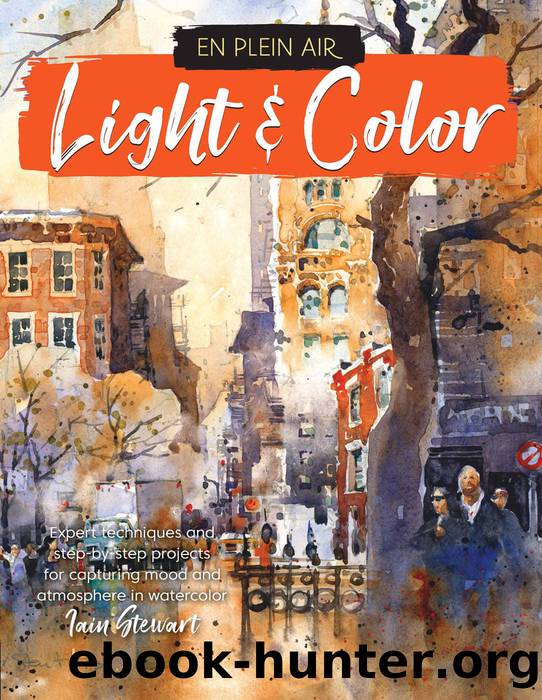Light & Color: Expert techniques and step-by-step projects for capturing mood and atmosphere in watercolor by Iain Stewart

Author:Iain Stewart
Language: eng
Format: epub
Publisher: Walter Foster Publishing
Published: 2021-11-15T00:00:00+00:00
These are the lessons that begin to make your work stand out. Now I ask the students to look for places they find interesting and try to recreate them. This is where things get fun. Think about the conditions when a certain reaction occurredâyou may have to do it 10 to 15 times. These are the exercises that begin to enlarge your arsenal and where advanced, painterly techniques are born.
Wash Techniques
Painting outside can be an extraordinary experience. In the early days, I only worked in my sketchbook, as it is the lightest setup and quickly movable.
Still, there are certain techniques you can only achieve on proper watercolor paper. I start most of my workshops with a simple exercise to reinforce basic techniques. As happens so often, techniques that should be second nature are, in fact, exceedingly difficult if you are not accustomed to using them. If you are used to painting objects by themselves or leaving holes in your washes for objects, then these techniques may require repeated practice.
One thing I cannot stress enough is that I do not paint objectsâI paint form and light. I may be working on a passage that includes a car or a group of people, but my only goal is to convey how light, color, and dark passages intertwine to create a scene. I do not paint around anything except for my lightest lights, preferring to create the atmosphere from the beginning. I do not use masking fluid. In my work, I would rather try and save the light from the beginning so I can see how it interacts with the painting throughout the process.
I always mix more paint than I think I will need to complete any passage. This benefits me in two ways: I do not have to stop a wash midway to try and mix more color. This interrupts the flow of the wash and creates unintentional results. Also, the leftover color mixtures allow me to use them again to help create a color harmony within the piece.
âWhen you are in the process of painting, imagine you are a millionaire. You cannot be concerned with how much your materials cost. Worry about that later.â
Download
This site does not store any files on its server. We only index and link to content provided by other sites. Please contact the content providers to delete copyright contents if any and email us, we'll remove relevant links or contents immediately.
Technical Art History by Jehane Ragai(248)
The Slavic Myths by Noah Charney(203)
Drawing Landscapes by Barrington Barber(184)
Compacts and Cosmetics by Madeleine Marsh(184)
Simply Artificial Intelligence by Dorling Kindersley(174)
Drawing for the Soul by Zoë Ingram(168)
The Art of Painting Sea Life in Watercolor by Maury Aaseng Hailey E. Herrera Louise De Masi and Ronald Pratt(156)
The Art of Portrait Drawing by Cuong i(153)
Preparing Dinosaurs by Wylie Caitlin Donahue;(146)
Egyptian art by Jean Capart(141)
A text-book of the history of painting by Van Dyke John Charles 1856-1932(137)
Pollak's Arm by Hans von Trotha(129)
Winslow Homer by Shibutani Baku(128)
Botanical Illustration by Valerie Price(119)
Through Japan with Brush & Ink by Chiura Obata(115)
Culture and Ideology under the Seleukids by Eva Anagnostou-Laoutides Stefan Pfeiffer(114)
Pornoterrorism: De-Aestheticising Power by Louis Armand Jaromir Lelek(111)
The Fashionable Mind by Kennedy Fraser(107)
Jane Evans. Chinese Brush Painting. A Complete Course in Traditional and Modern Techniques by Unknown(103)
